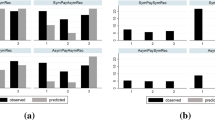Abstract
The Adjusted Winner mechanism for two-player bargaining has been theoretically shown to produce “fair” (efficient and envy-free) outcomes (Brams and Taylor 1996). We study this claim experimentally in a bilateral bargaining game of incomplete information for two divisible goods using three information conditions. Results indicate that the Adjusted Winner mechanism can be quite effective in achieving both efficient, equitable and envy-free outcomes in an experimental setting but results vary greatly depending on the knowledge that each party has of the preferences of their bargaining partner. Under conditions of common knowledge, when players have competing preferences, their bilateral decisions converge toward efficient outcomes, yet only one-third can be classified as “envy-free.” In an environment where there is more uncertainty about preferences, pronounced strategic bidding emerges yet the result is twice as many envy-fee outcomes with increased levels of efficiency. Despite the fact that players dramatically misrepresent their true valuation for objects when ordinal preferences are commonly known to be complementary, both efficiency and envy-freeness approach maximum levels.
Similar content being viewed by others
References
Bazerman, M. H., J. Baron, and K. Shonk. (2001). You can’t Enlarge the Pie: The Psychology of Ineffective Government. New York: Basic Books.
Bazerman, M. H., T. Magliozzi, and M. A. Neale. (1985). “Integrative Bargaining in a Competitive Market,” Organization Behavior and Human Performance 34, 294–313.
Brams, S. J. and D. M. Kilgour. (1996). “Bargaining Procedures that Induce Honesty,” Group Decision and Negotiation 5, 239–262.
Brams, S. J. and A. D. Taylor. (1996). Fair Division. Cambridge: Cambridge University Press.
Brams, S. J. (2005). Fair Division. To appear in Oxford Handbook of Political Economy, B. R. Weingast and Donald Wittman (eds.), Oxford University Press.
Brams, S. J. and A. D. Taylor. (1999). The Win-Win Solution: Guaranteeing Fair Shares to Everybody. New York: W.W. Norton Books.
Chatterjee, K. and W. Samuelson. (1983). “Bargaining Under Incomplete Information,” Operations Research 31, 835–851.
Daniel, T. E. (1975). “A Revised Concept of Distributional Equity,” Journal of Economic Theory 11, 94–109.
Daniel, T. E., D. A. Seale, and A. Rapoport. (1998). “Strategic Play and Adaptive Learning in the Sealed Bid Bargaining Mechanism,” Journal of Mathematical Psychology 42, 133–166.
Denton, M. J., S. J. Rassenti and V. L. Smith. (2001). “Spot Market Mechanism Design and Competitivity Issues in Electric Power,” Journal or Economic Behavior and Organization 44, 435–453.
Foley, D. K. (1967). “Resource Allocation and the Public Sector,” Yale Economic Essays 7, 45–98.
Fisher, R. B. and W. M. Ury. (1992). Getting to Yes. New York: Penguin Books.
Lax, D. and J. Sebenius. (1986). The Manager as Negotiator. New York: Free Press.
Leininger, W., P. B. Linhart, and R. Radner. (1989). “Equilibria of the Sealed-Bid Mechanism for Bargaining with Incomplete Information,” Journal of Economic Theory 48, 63–106.
Mumpower, J. L., J. Sheffield, T. A. Darling, and R. G. Milter. (2004). “The Accuracy of Post-Negotiation Estimates of the Other Negotiator’s Payoff,” Group Decision and Negotiation 13, 259–290.
Myerson, R. B. and M. A. Satterthwaite. (1983). “Efficient Mechanisms for Bilateral Trading,” Journal of Economic Theory 29, 265–281.
Nalebuff, B. (2001). “Review of The Win-Win Solution: Guaranteeing Fair Shares to Everybody,” Journal of Economic Literature 39, 125–127.
Neale, M. A. and G. B. Northcraft. (1986). “Experts, Amateurs, and Refrigerators: Comparing Expert and Amateur Negotiators in a Novel Task,” Organizational Behavior and Human Decision Processes 38, 305–317.
Parco, J. E. (2002). Two-Player Bargaining Under Incomplete Information: An Experimental Study of New Mechanisms. Department of Management and Policy, University of Arizona, UMI-published Ph.D. Dissertation.
Parco, J. E. (2004). Strategic Resiliency in Bargaining. Department of Management, United States Air Force Academy, Unpublished manuscript.
Parco, J. E. and A. Rapoport. (in press). “Enhancing Honesty in Bargaining Under Incomplete Information: An Experimental Study of the Bonus Procedure,” Group Decision and Negotiation.
Parco, J. E., A. Rapoport, D. A. Seale, W. E. Stein, and R. Zwick. (in press). “The Sealed-Bid Double-Auction: Revealing Information in Multistage Bargaining,” in S. Huck (ed.), Essays in Honor of Werner Guth. LEA Publishers.
Radner, R. and A. Schotter. (1989). “The Sealed-Bid Mechanism: An Experimental Stud,” Journal of Economic Theory 48, 179–220.
Rapoport, A., T. E. Daniel, and D. A. Seale. (1998). “Reinforcement-Based Adaptive Learning in Asymmetric Two-Player Bargaining with Incomplete Information,” Experimental Economics 1, 221–253.
Rapoport, A. and M. Fuller. (1995). “Bidding Strategies in a Bilateral Monopoly with Two-Sided Incomplete Information,” Journal of Mathematical Psychology 39, 179–196.
Satterthwaite, M. A. and S. R. Williams. (1989). “Bilateral Trade with the Sealed-Bid k-Double Auction: Existence and Efficiency,” Journal of Economic Theory 48, 107–133.
Seale, D. A., T. E. Daniel, and A. Rapoport. (2001). “The Information Advantage in Two-Player: Bargaining with Incomplete Information,” Journal of Economic Behavior and Organization 44, 177–200.
Schneider, G. and U. S. Kramer. (2004). “The Limitations of Fair Division: An Experimental Assessment of Three Procedures,” Journal of Conflict Resolution 48, 506–524.
Stein, W. E. and T. E. Daniel. (2002). The Adjusted Winner Method Under Incomplete Information. Unpublished manuscript, Eller College of Business, the University of Arizona.
Valley, K. L., L. Thompson, R. Gibbons, and M. H. Bazerman. (2002). “How Communication Improves Efficiency in Bargaining,” Games and Economic Behavior, 38, 127–155.
Varian, H. (1974). “Equity, Envy, and Efficiency,” Journal of Economic Theory 9, 63–91.
Walton, R. E. and R. B. McKersie. (1965). A Behavioral Theory of Labor Negotiations: An Analysis of a Social Interaction System, New York: McGraw-Hill.
Author information
Authors and Affiliations
Corresponding author
Rights and permissions
About this article
Cite this article
Daniel, T.E., Parco, J.E. Fair, Efficient and Envy-Free Bargaining: An Experimental Test of the Brams-Taylor Adjusted Winner Mechanism. Group Decis Negot 14, 241–264 (2005). https://doi.org/10.1007/s10726-005-1245-z
Issue Date:
DOI: https://doi.org/10.1007/s10726-005-1245-z



